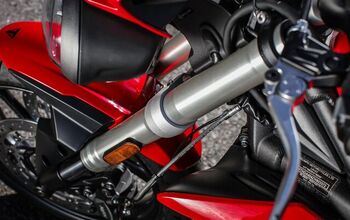Kawasaki Hydrogen Prototype Makes Public Debut

Demo laps at Suzuka show proof of concept, but still a long ways to go
Kawasaki conducted the world’s first public demonstration of a hydrogen-burning motorcycle, debuting a prototype during the Suzuka 8 Hours endurance race last weekend. Kawasaki first announced plans for a hydrogen internal combustion engine motorcycle back in 2022, with a mock-up based on a Ninja H2 SX. Since then, Kawasaki has continued its development in private before debuting this new, functional prototype in front of a public audience.
Alongside the Suzuka demonstration, Kawasaki also released a video showcasing the prototype including footage shot at the Kawasaki-owned Autopolis circuit near Kumamoto, Japan.
The prototype uses a version of the Ninja H2’s 998cc Inline-Four supercharged engine, modified to directly inject hydrogen right into the cylinders. Combustion isn’t that different from a conventional gas-powered engine: air is mixed with fuel which is then ignited. With hydrogen as the fuel, the main exhaust byproduct is water, though there is a bit of carbon dioxide emitted because the engine still uses regular engine oil.
What looks like a pair of chunky saddlebags are actually hydrogen fuel canisters, which are filled via a port on the end of the tail. Combined with the angular fairing, the prototype looks a bit like the lovechild of a Honda NM4 and the USS Enterprise.
The size of the canisters highlight one of the challenges of a hydrogen ICE motorcycle. Kawasaki says hydrogen burns quicker and in a wider range of conditions than gasoline, but it is not as dense and is more difficult to store, requiring more volume to provide the same amount of energy as gasoline. Hydrogen is also lighter than gasoline, so the decision to place the storage tanks alongside the tail doesn’t move the weight distribution as far back as it looks, but Kawasaki still had to design a new chassis to accommodate them.
There is still a long way to go before a hydrogen-burning motorcycle is commercially viable. Developing the technology is an important step, but there will also need to be enough infrastructure to support widespread adoption. Kawasaki is a member of HySE (Hydrogen Small mobility & Energy technology), a research association that includes fellow Japanese companies Honda, Suzuki, Yamaha, and Toyota. HySE conducts research on hydrogen engines, hydrogen filling systems and fuel supply systems to support small mobility vehicles.
Kawasaki Hydrogen ICE Prototype Gallery
Become a Motorcycle.com insider. Get the latest motorcycle news first by subscribing to our newsletter here.

Dennis has been a part of the Motorcycle.com team since 2008, and through his tenure, has developed a firm grasp of industry trends, and a solid sense of what's to come. A bloodhound when it comes to tracking information on new motorcycles, if there's a new model on the horizon, you'll probably hear about it from him first.
More by Dennis Chung
































Comments
Join the conversation
@ Robert:
Hydrogen fuel tanks are pressure vessels and have DOT impact standards to help insure that the sparks and hydrogen don't come in contact. They also have a defined lifespan after which they must be replaced or the vehicle scrapped. For the Toyota Mirai this is 15 years from tank manufacturing date.
These are similar rules to natural gas vehicles. CNG and LNG vehicle also have an expiration date for their tanks as well as mandatory inspections. For vehicles 10,000 GVWR and under that is every 3 years. For vehicles over 10,000 it is every 1 year.
The cost of the tanks, inspection requirements, and expiration date are one of the reasons that CNG vehicles never took off despite the USA already having a nationwide natural gas pipeline network. It is yet another reason why the economics of H2 don't work for ground transportation.
H2 combustion engines may work in stationary applications. If there's an explosion risk then install them away from people. With oceans as a fuel source of H2 in H2O, I can't help but think that somehow God thought it was a good idea to give us plenty of energy, hence, oceans of water. A matter of figuring out how to split off the hydrogen from the oxygen, which we haven't yet figured out how to do efficiently. When we burn the H2 it goes back to water so, endless supply. In the meantime there is a finite amount of oil in the ground which maybe God intended to last us a few thousand generations, and we are burning it up in a century or two.